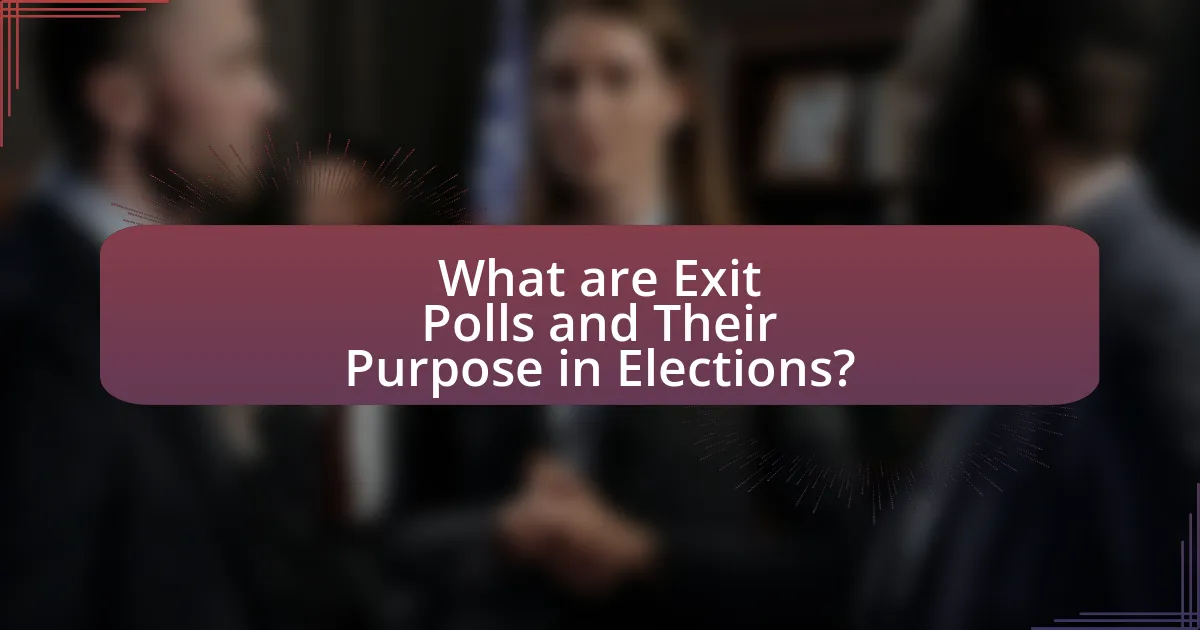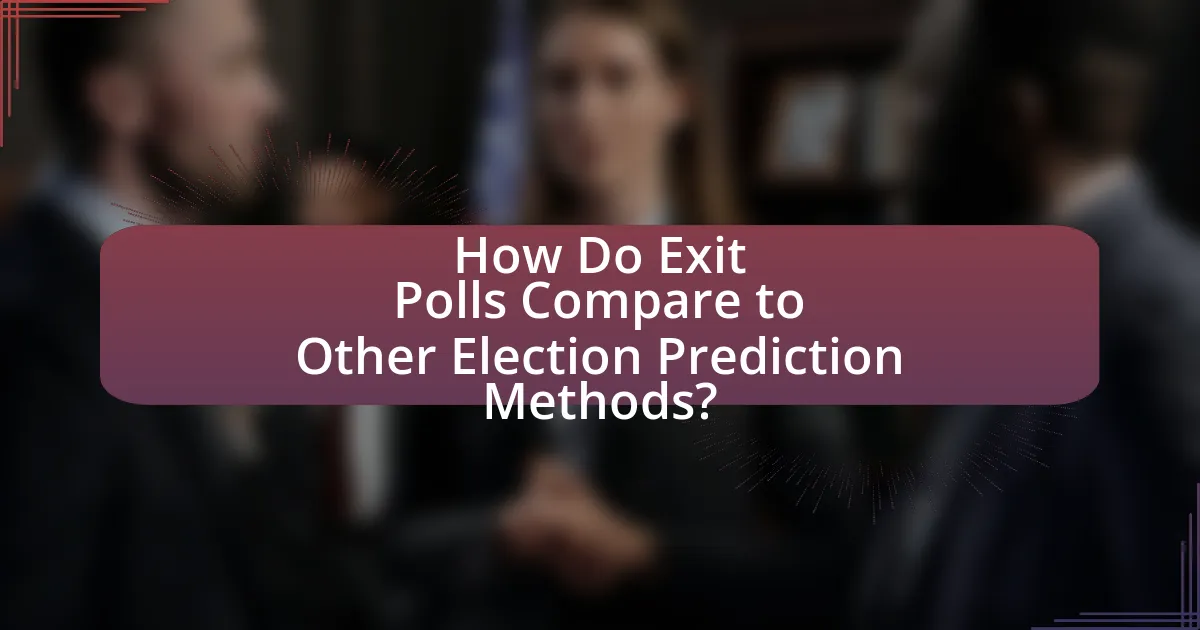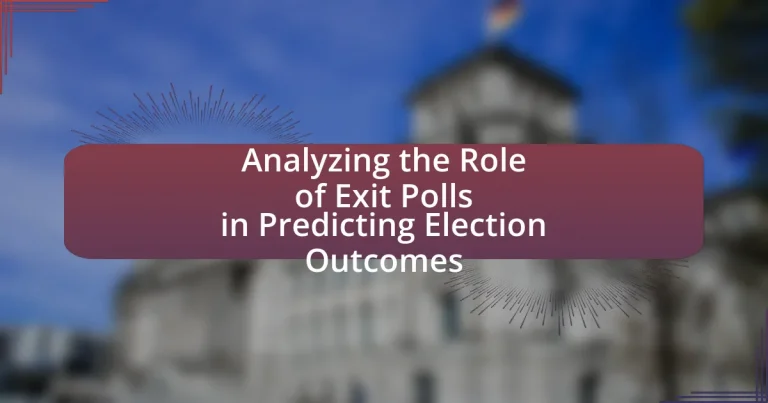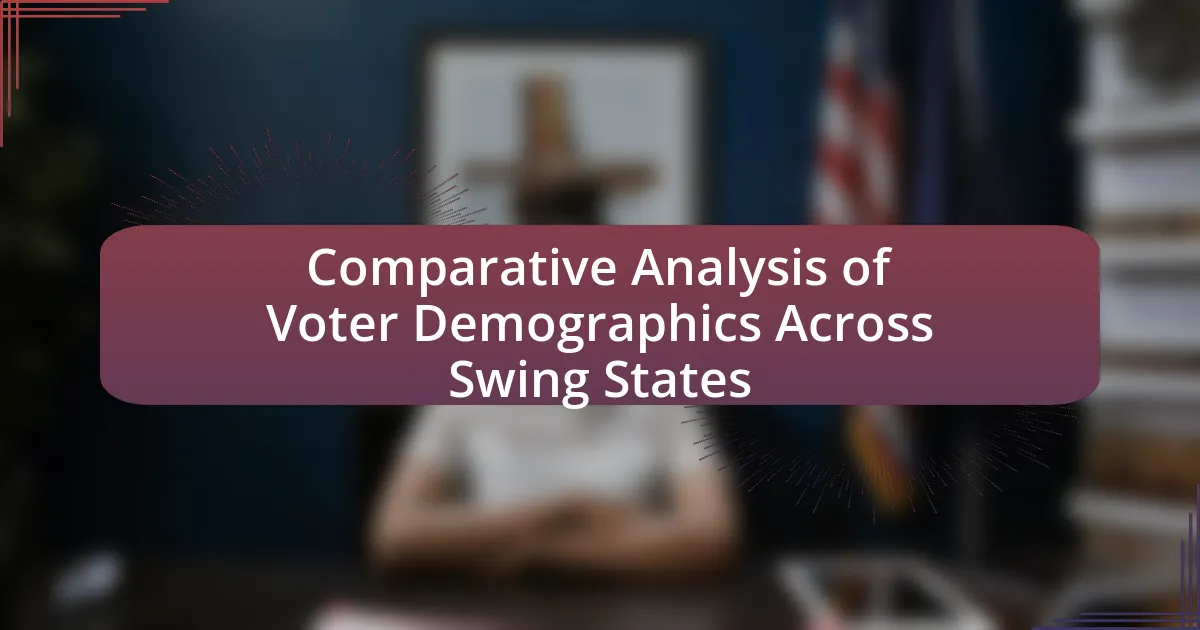Exit polls are surveys conducted with voters immediately after they cast their ballots, serving to predict election outcomes and analyze voter behavior. This article examines the methodologies used in exit polling, including stratified sampling and real-time data collection, and discusses the key stakeholders involved, such as polling organizations and media outlets. It highlights the importance of exit polls in shaping public perception and media narratives during elections, while also addressing their limitations, such as sampling bias and inaccuracies in predictions. Additionally, the article explores emerging trends in exit polling, including the impact of technology and social media on data collection and analysis, providing insights into voter demographics and turnout.

What are Exit Polls and Their Purpose in Elections?
Exit polls are surveys conducted with voters immediately after they have cast their ballots, aimed at predicting election outcomes and understanding voter behavior. Their primary purpose is to provide early insights into how different demographic groups voted, which can help media outlets and analysts forecast results before official counts are available. For instance, during the 2020 U.S. presidential election, exit polls indicated trends in voter preferences that aligned closely with the final results, demonstrating their effectiveness in gauging public sentiment and electoral trends.
How are Exit Polls Conducted?
Exit polls are conducted by surveying voters immediately after they cast their ballots at polling places. Pollsters typically select a random sample of voters from various locations to ensure a representative demographic. The survey includes questions about the voter’s choice and demographic information, which helps analysts predict election outcomes based on the collected data. For instance, during the 2020 U.S. presidential election, major news organizations employed exit polls to gauge voter sentiment, revealing trends that aligned closely with actual results, thus validating the methodology.
What methodologies are used in gathering Exit Poll data?
Exit Poll data is primarily gathered using methodologies such as stratified sampling, face-to-face interviews, and telephone surveys. Stratified sampling ensures that various demographic groups are represented proportionately, enhancing the accuracy of the results. Face-to-face interviews are conducted at polling places immediately after voters cast their ballots, allowing for real-time data collection. Telephone surveys may also be employed to reach a broader audience, particularly in areas where in-person data collection is challenging. These methodologies are validated by historical data showing that well-structured exit polls can accurately reflect voter behavior and predict election outcomes, as evidenced by their consistent use in major elections.
Who are the key stakeholders involved in Exit Polls?
The key stakeholders involved in exit polls include polling organizations, political parties, media outlets, and voters. Polling organizations conduct the surveys to gather data on voter preferences immediately after they cast their ballots. Political parties utilize exit poll data to gauge their electoral performance and strategize for future elections. Media outlets report on exit poll results to inform the public and provide analysis during election coverage. Voters are also stakeholders as their responses directly influence the accuracy and relevance of the exit polls. These stakeholders collectively contribute to the understanding and interpretation of election outcomes, making exit polls a critical component of the electoral process.
Why are Exit Polls Important for Election Predictions?
Exit polls are important for election predictions because they provide immediate insights into voter behavior and preferences as they leave polling places. These surveys capture demographic data and voting choices, allowing analysts to project election outcomes before official results are available. For instance, during the 2004 U.S. presidential election, exit polls indicated John Kerry would win, but the final results showed George W. Bush’s victory, highlighting both the predictive power and potential inaccuracies of exit polls. Despite their limitations, exit polls remain a critical tool for understanding electoral trends and informing media coverage on election night.
How do Exit Polls influence public perception of election outcomes?
Exit polls significantly influence public perception of election outcomes by providing immediate insights into voter behavior and preferences. These polls, conducted as voters leave polling places, can shape narratives about the election results before official counts are available. For instance, in the 2004 U.S. presidential election, early exit poll results suggested a strong lead for John Kerry, which led to widespread media coverage and public speculation about his potential victory, despite George W. Bush ultimately winning the election. This phenomenon illustrates how exit polls can create a perception of momentum or inevitability, impacting voter confidence and turnout. Additionally, exit polls can reinforce or challenge existing biases, as seen in the 2016 election, where discrepancies between polls and actual results led to debates about polling accuracy and voter sentiment.
What role do Exit Polls play in media reporting during elections?
Exit polls serve as a critical tool in media reporting during elections by providing immediate insights into voter behavior and preferences. These polls are conducted as voters leave polling places, capturing demographic data and voting choices, which allows media outlets to project election outcomes before official results are available. For instance, during the 2020 U.S. presidential election, exit polls indicated trends that helped media organizations forecast the likelihood of Joe Biden winning key battleground states, influencing public perception and narrative around the election. The accuracy of exit polls can vary, but they are often used to validate or challenge preliminary results, shaping the discourse around electoral integrity and voter sentiment.
What are the Limitations of Exit Polls?
Exit polls have several limitations that can affect their accuracy and reliability. One major limitation is the potential for sampling bias, as exit polls may not represent the entire voting population if certain demographics are underrepresented. For instance, if younger voters are less likely to participate in exit polls, the results may skew towards older voters’ preferences. Additionally, respondents may provide socially desirable answers rather than their true voting intentions, leading to inaccurate data. Historical instances, such as the 2004 U.S. presidential election, demonstrated discrepancies between exit poll predictions and actual results, highlighting the challenges in forecasting outcomes based on this method. Furthermore, the timing of exit polls can also impact their accuracy, as they may not account for last-minute changes in voter sentiment.
How can sampling errors affect Exit Poll results?
Sampling errors can significantly distort Exit Poll results by misrepresenting the voting population. When a sample does not accurately reflect the demographics or preferences of the entire electorate, the predictions made based on that sample can be misleading. For instance, if an Exit Poll over-represents a demographic group that tends to vote for a particular candidate, the results may inaccurately suggest that candidate has more support than they actually do. Historical data from the 2000 U.S. presidential election illustrates this; Exit Polls underestimated George W. Bush’s support among certain voter groups, leading to incorrect forecasts of the election outcome. Thus, sampling errors can lead to flawed interpretations of voter sentiment and potentially impact public perception and media narratives surrounding an election.
What factors can lead to inaccurate predictions from Exit Polls?
Inaccurate predictions from exit polls can result from several factors, including sampling errors, non-response bias, and the timing of data collection. Sampling errors occur when the selected sample does not accurately represent the voting population, leading to skewed results. Non-response bias arises when certain demographic groups are less likely to participate in the poll, which can distort the overall findings. Additionally, if exit polls are conducted too early, they may not capture late-breaking trends or shifts in voter sentiment, further compromising accuracy. Historical instances, such as the 2000 U.S. presidential election, illustrate how these factors can lead to significant discrepancies between exit poll predictions and actual election outcomes.

How Do Exit Polls Compare to Other Election Prediction Methods?
Exit polls provide immediate insights into voter behavior and preferences after they cast their votes, making them distinct from other election prediction methods such as pre-election polls, statistical models, and historical data analysis. While pre-election polls gauge voter intentions before the election, exit polls reflect actual voting outcomes, offering a real-time snapshot of the electorate’s choices. Statistical models, which often incorporate various data points and trends, can predict outcomes based on historical patterns but may lack the immediacy and direct feedback that exit polls provide. For instance, during the 2020 U.S. presidential election, exit polls indicated a significant turnout among specific demographics, which helped validate the predictions made by various models and polls. Thus, exit polls serve as a crucial tool for understanding election dynamics, complementing other methods by providing a direct measure of voter sentiment at the moment of voting.
What are the differences between Exit Polls and Pre-Election Polls?
Exit polls and pre-election polls differ primarily in their timing and purpose. Exit polls are conducted immediately after voters leave polling places on Election Day to gauge how they voted and to predict election outcomes, while pre-election polls are conducted before the election to measure voter sentiment and preferences. For instance, exit polls can provide real-time insights into voter behavior, often influencing media coverage and public perception on election night, whereas pre-election polls aim to forecast results based on a sample of the electorate, typically weeks or days before the election. This distinction is crucial as exit polls reflect actual voting behavior, while pre-election polls are based on respondents’ intentions, which may change leading up to the election.
How do timing and methodology differ between these polling types?
Timing and methodology differ significantly between exit polls and traditional polls. Exit polls are conducted immediately after voters leave polling stations, capturing real-time data on voter behavior and preferences, while traditional polls are often conducted days or weeks before an election, relying on respondents’ recollections and predictions about their voting intentions. For instance, exit polls can provide immediate insights into demographic trends and voter turnout, whereas traditional polls may not accurately reflect last-minute changes in voter sentiment due to their timing. This immediacy in exit polling methodology allows for a more accurate snapshot of the electorate at the moment of decision, contrasting with the predictive nature of traditional polling methods that may miss late shifts in public opinion.
What advantages do Exit Polls have over Pre-Election Polls?
Exit polls provide immediate insights into voter behavior after they cast their ballots, whereas pre-election polls rely on predictions before voting occurs. This immediacy allows exit polls to capture actual voting patterns and demographic trends, leading to more accurate projections of election outcomes. For instance, during the 2004 U.S. presidential election, exit polls indicated a strong lead for John Kerry, which contrasted with pre-election polls that suggested a tighter race, highlighting the potential discrepancies in predictive accuracy. Additionally, exit polls can identify shifts in voter sentiment that occur right before or during the election, offering a real-time snapshot that pre-election polls cannot provide.
How do Exit Polls interact with Voter Turnout Data?
Exit polls interact with voter turnout data by providing insights into the demographics and motivations of those who participated in an election. Exit polls are conducted immediately after voters cast their ballots, capturing information about their choices and characteristics, which can then be analyzed in relation to overall voter turnout statistics. For instance, if exit polls indicate a higher turnout among younger voters compared to previous elections, this data can suggest shifts in electoral engagement and influence predictions about future outcomes. Studies have shown that exit polls can accurately reflect turnout trends; for example, the 2020 U.S. presidential election exit polls indicated a significant increase in participation among minority groups, correlating with reported turnout data from the U.S. Census Bureau. This interaction helps analysts understand not only who voted but also the factors that may have driven turnout, thereby enhancing the predictive power of exit polls in assessing election results.
What insights can Exit Polls provide about voter demographics?
Exit polls provide critical insights into voter demographics by capturing data on the characteristics of individuals who participated in an election. These polls typically gather information on age, gender, race, education level, and income, allowing analysts to understand how different demographic groups voted. For instance, in the 2020 U.S. presidential election, exit polls indicated that 51% of women voted for Joe Biden, while 47% of men did the same, highlighting gender differences in voting behavior. Additionally, exit polls can reveal shifts in demographic trends over time, such as increasing support for a candidate among younger voters or minority groups, which can inform future campaign strategies and policy decisions.
How does voter turnout impact the reliability of Exit Polls?
Voter turnout significantly impacts the reliability of exit polls by influencing the representativeness of the sample surveyed. When turnout is high, exit polls are more likely to reflect the overall electorate’s preferences, as a larger and more diverse group of voters is included in the sample. Conversely, low voter turnout can skew results, as the demographics of those who do vote may not accurately represent the broader population. For instance, in the 2016 U.S. presidential election, lower turnout among younger voters led to exit polls underestimating support for certain candidates, highlighting how turnout disparities can affect polling accuracy.

What Trends are Emerging in the Use of Exit Polls?
Emerging trends in the use of exit polls include increased reliance on technology for data collection and analysis, as well as a growing emphasis on demographic segmentation to enhance accuracy. Recent elections have seen organizations utilizing mobile devices and online platforms to gather real-time data, which allows for quicker reporting and more dynamic analysis. Additionally, the incorporation of advanced statistical methods and machine learning algorithms is becoming common, enabling pollsters to better account for variables such as voter turnout and demographic shifts. For instance, the 2020 U.S. presidential election highlighted the importance of understanding diverse voter groups, leading to more tailored exit polling strategies that reflect changing societal dynamics.
How has technology changed the landscape of Exit Polling?
Technology has significantly transformed exit polling by enhancing data collection, analysis, and reporting processes. The introduction of mobile devices and online platforms allows pollsters to gather responses in real-time, increasing the speed and accuracy of data collection. For instance, the use of tablets and smartphones enables pollsters to reach a broader demographic, capturing a more representative sample of voters. Additionally, advanced statistical software and algorithms facilitate more sophisticated data analysis, allowing for immediate insights into voter behavior and trends. According to a study by the Pew Research Center, the integration of technology in exit polling has improved the reliability of predictions, as seen in the 2020 U.S. presidential election, where exit polls were able to reflect shifts in voter sentiment more accurately than in previous years.
What new tools are being utilized for more accurate Exit Polls?
New tools being utilized for more accurate exit polls include advanced data analytics software, machine learning algorithms, and mobile survey applications. These technologies enhance the precision of exit polls by allowing for real-time data collection and analysis, which improves the ability to capture voter sentiment and demographic trends. For instance, machine learning algorithms can analyze patterns in voter behavior based on historical data, while mobile survey applications facilitate immediate feedback from voters as they leave polling stations. This integration of technology has been shown to increase the reliability of exit poll results, as evidenced by studies indicating that data-driven approaches yield more accurate predictions of election outcomes compared to traditional methods.
How are social media and online platforms influencing Exit Poll results?
Social media and online platforms significantly influence exit poll results by shaping voter perceptions and behaviors in real-time. These platforms facilitate the rapid dissemination of information, allowing voters to share their experiences and opinions immediately after casting their ballots, which can skew the data collected by exit polls. For instance, a study by the Pew Research Center found that 69% of adults in the U.S. use social media, which amplifies the voices of certain demographics and can lead to biased exit poll outcomes if those voices dominate the conversation. Additionally, the presence of misinformation on social media can alter voter sentiment and expectations, further complicating the accuracy of exit polls.
What Best Practices Should Be Followed When Analyzing Exit Polls?
When analyzing exit polls, it is essential to ensure that the sample size is sufficiently large and representative of the electorate to yield reliable results. A larger sample size minimizes the margin of error and enhances the accuracy of predictions. Additionally, analysts should consider the timing of the polls, as early exit polls may not reflect final voter sentiment, especially in close races.
Furthermore, it is crucial to account for demographic factors such as age, race, and gender, as these can significantly influence voting behavior. Analysts should also compare exit poll results with actual election outcomes to assess the accuracy of the polls and refine methodologies for future elections. Historical data can provide context, as studies have shown that exit polls can be more accurate in certain demographics and less so in others, highlighting the importance of tailored analysis.
How can analysts ensure the accuracy of their Exit Poll interpretations?
Analysts can ensure the accuracy of their Exit Poll interpretations by employing rigorous sampling techniques and validating results against actual election outcomes. Utilizing a representative sample of voters, which reflects the demographics of the electorate, minimizes bias and enhances reliability. For instance, the American Association for Public Opinion Research emphasizes the importance of stratified sampling to capture diverse voter segments accurately. Additionally, analysts should cross-verify exit poll data with official election results to identify discrepancies and adjust interpretations accordingly. Historical data shows that accurate exit poll predictions often correlate with methodological rigor, as seen in the 2008 U.S. presidential election, where well-executed exit polls closely matched final vote counts.
What common pitfalls should be avoided in Exit Poll analysis?
Common pitfalls to avoid in Exit Poll analysis include sampling bias, misinterpretation of data, and over-reliance on early results. Sampling bias occurs when the selected respondents do not accurately represent the overall voter population, leading to skewed results. Misinterpretation of data can happen when analysts draw conclusions without considering the context or margin of error, which can mislead stakeholders. Over-reliance on early results can create a false narrative about election outcomes, as these results may not reflect the final tally due to late-arriving votes. These pitfalls can significantly impact the accuracy and credibility of exit poll findings.





